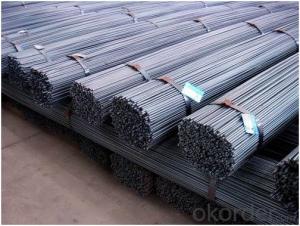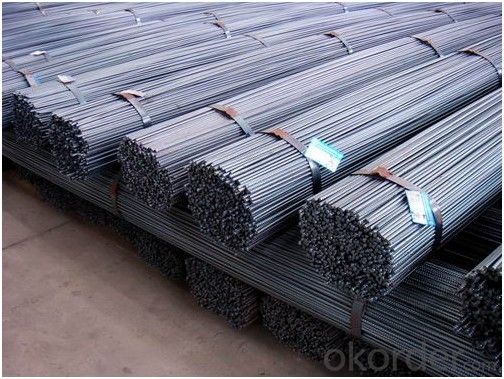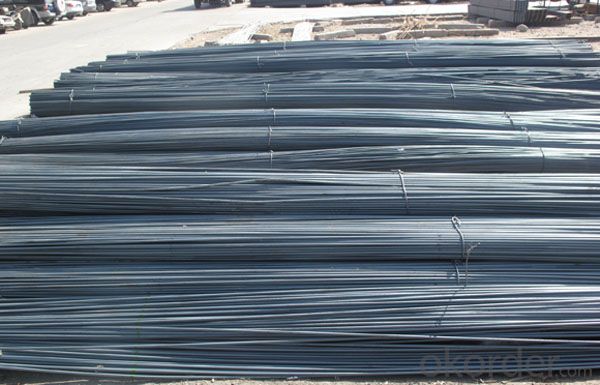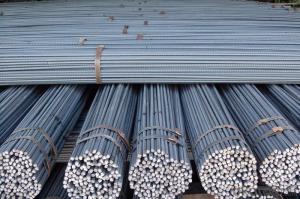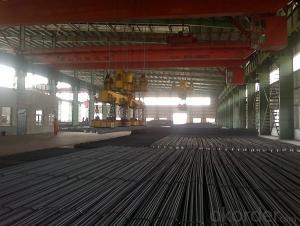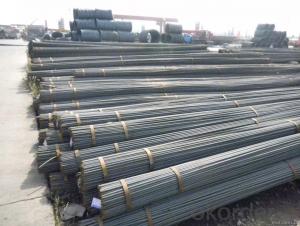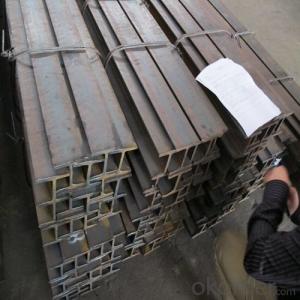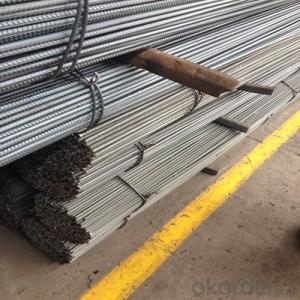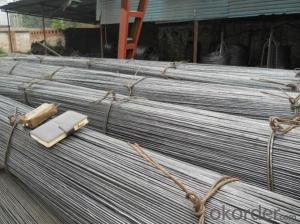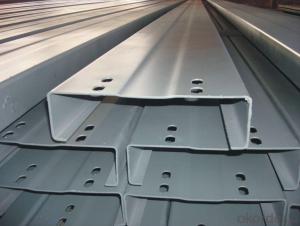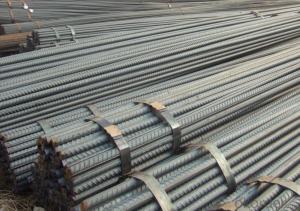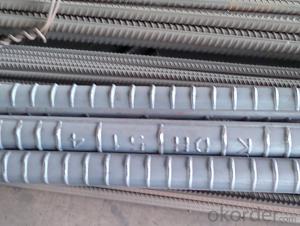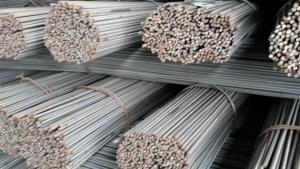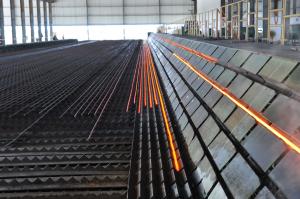Deformed Steel Bar, Steel,Hot Rolled Steel Structure,China Manufacture H500B 12M
- Loading Port:
- Tianjin
- Payment Terms:
- TT OR LC
- Min Order Qty:
- 24 m.t.
- Supply Capability:
- 30000 m.t./month
OKorder Service Pledge
OKorder Financial Service
You Might Also Like
Packaging & Delivery
| Packaging Detail: | in bundles or as customer's requirement |
| Delivery Detail: | Within 30days after receiving your deposit or copy of L/C |
Specifications
Hot Rolled Steel Rebar HRB 500B
1.China direct supplier
2.Best service
3.Competitive price
4.Quantity assured
Product Description
| Name | Steel,Hot Rolled Steel Structure,Deformed Steel Bar,China Manufacture H500B 12M |
| Standard | ASTM A615 /BS BS 4449 /GB HRB/ JIS G3112 |
| Grade | HRB500B |
| Diameter | 12mm-40mm |
| Length | 6-12m |
| Technique | Low temperature hot-rolling reinforcing deformed steel rebar |
| Tolerance | As the standard or as your requirement |
| Application | Building, construction, road, bridge,etc |
| Certificated | BV |
| MOQ | 500tons per size steel rebar |
| Packing details | Steel rebar packed in bundle or as your requirement |
| Delivery | Within 30 days after deposit |
| Payment | T/T or L/C |
Chemical Composition
Grade | Technical data of the original chemical composition (%) | |||||||
C | Mn | Si | S | P | V | |||
HRB400 | ≤0.25 | ≤1.60 | ≤0.80 | ≤0.045 | ≤0.045 | 0.04-0.12 | ||
Physics capability | ||||||||
Yield Strength(N/cm2) | Tensile Strength(N/cm2) | Elongation (%)
| ||||||
≥400 | ≥570 | ≥14 | ||||||
Theorectical weight
Diameter (MM) | Cross Sectional Area (MM2) | Theorectical Weight (KG/M) | Weight of 12M Bar (KG) | A Ton Contains 12M Bars (PCS) |
| 6 | 28.27 | 0.222 | 2.664 | 375.38 |
| 8 | 50.27 | 0.395 | 4.74 | 210.97 |
| 10 | 78.54 | 0.617 | 7.404 | 135.06 |
| 12 | 113.1 | 0.888 | 10.656 | 93.84 |
| 14 | 153.9 | 1.21 | 14.52 | 68.87 |
| 16 | 201.1 | 1.58 | 18.96 | 52.74 |
| 18 | 254.5 | 2 | 24 | 41.67 |
| 20 | 314.2 | 2.47 | 29.64 | 33.74 |
| 22 | 380.1 | 2.98 | 35.76 | 27.96 |
| 25 | 490.9 | 3.85 | 46.2 | 21.65 |
| 28 | 615.8 | 4.83 | 57.96 | 17.25 |
| 32 | 804.2 | 6.31 | 75.72 | 13.21 |
| 36 | 1018 | 7.99 | 98.88 | 10.43 |
| 40 | 1257 | 9.87 | 118.44 | 8.44 |
Product Picture
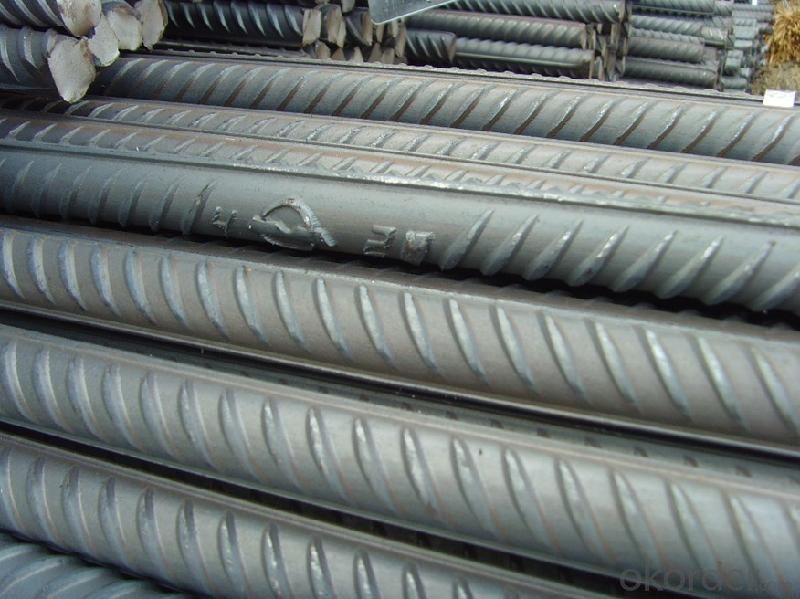
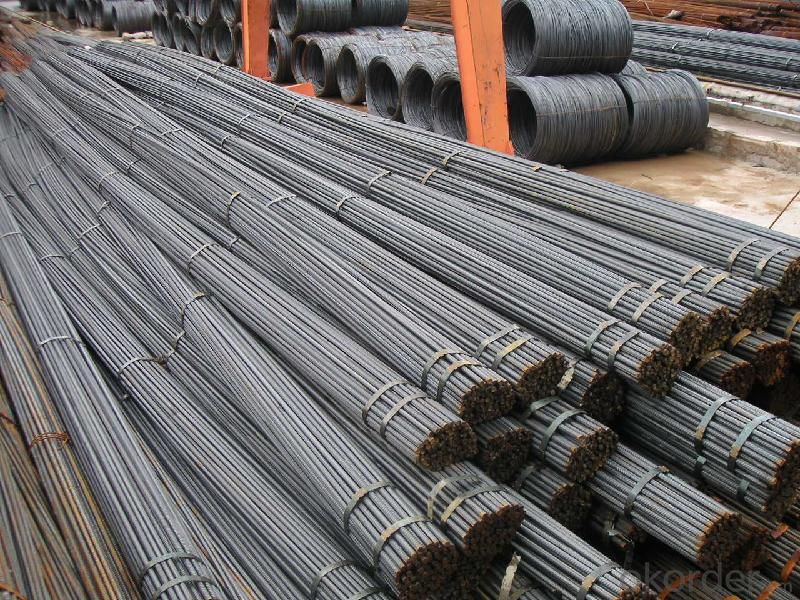
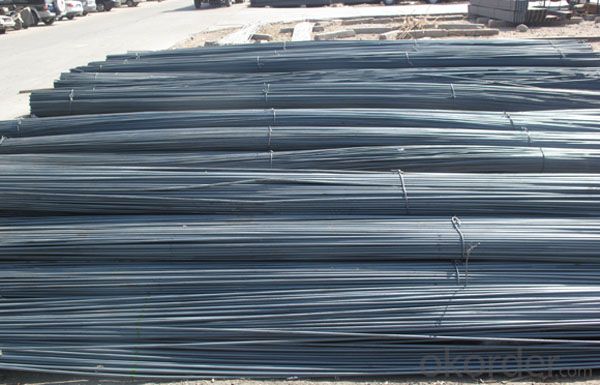
- Q: Can steel rebars be used in earthquake-resistant buildings?
- Yes, steel rebars can be used in earthquake-resistant buildings. Steel rebars are commonly used in reinforced concrete structures, including earthquake-resistant buildings, to enhance their strength and structural integrity. The steel reinforcement helps to distribute and absorb the forces generated during an earthquake, preventing the structure from collapsing or sustaining significant damage.
- Q: How do steel rebars contribute to the load-bearing capacity of structures?
- The load-bearing capacity of structures is enhanced by steel rebars in various ways. Firstly, they increase the tensile strength of the concrete, which is weak in tension despite its strength in compression. This addition of steel rebars significantly boosts the structural tensile strength, a crucial aspect considering the different loads structures face, such as dead loads (e.g. the structure's weight), live loads (e.g. occupants, furniture), and environmental loads (e.g. wind, earthquakes). Secondly, steel rebars aid in preventing cracking and improving the overall durability of the structure. Concrete has a tendency to shrink and crack due to factors like temperature changes and moisture. By incorporating steel rebars within the concrete, they act as reinforcement, ensuring a more even distribution of the load and decreasing the likelihood of cracking. This, in turn, enhances the longevity and structural integrity of the building. Moreover, steel rebars also provide support and stability to the structure, particularly against lateral forces that may arise during high winds or seismic events. By securely anchoring the rebars into the foundation or other structural elements, a strong connection is formed, capable of withstanding these lateral loads and safeguarding the structure from collapse or damage. To summarize, steel rebars play a vital role in enhancing the load-bearing capacity of structures through bolstering the tensile strength of the concrete, preventing cracking, and providing stability and support. Their integration into the structural design is paramount for ensuring the safety, durability, and long-term functionality of buildings and other forms of infrastructure.
- Q: How do steel rebars affect the constructability of a project?
- Steel rebars play a vital role in enhancing project constructability in multiple ways. To start, they offer structural strength and stability to reinforced concrete structures. By reinforcing the concrete, rebars help distribute the load more evenly, thus increasing overall project strength and durability. Additionally, steel rebars facilitate the construction of larger and taller structures. They provide the necessary tensile strength to counteract concrete's weakness in resisting tension forces. This empowers engineers and architects to design and build structures with greater flexibility, leading to more innovative and impressive architectural designs. Furthermore, steel rebars contribute to project integrity and safety. They act as a reinforcement against external forces like earthquakes, wind loads, and impacts. By resisting these forces, they enhance structural stability, thus reducing the risk of collapse or damage during extreme conditions. Moreover, steel rebars contribute to project longevity and maintenance. Thanks to their high tensile strength and corrosion resistance, they help extend the structure's lifespan. This, in turn, reduces the need for frequent repairs and replacements, resulting in cost savings and minimal disruption to the project. Additionally, the use of steel rebars simplifies the construction process. They can be easily cut, bent, and shaped to fit specific requirements, making them highly adaptable to various project needs. This flexibility allows for efficient construction, reducing time and effort required for implementation. In conclusion, steel rebars have a significant impact on project constructability by providing strength, stability, flexibility, safety, longevity, and simplification. Their use enables the construction of resilient and visually appealing structures, guaranteeing project success and sustainability.
- Q: What are the different types of steel rebars used in retaining wall constructions?
- There are several types of steel rebars commonly used in retaining wall constructions, including plain carbon steel rebars, epoxy-coated rebars, galvanized rebars, and stainless steel rebars. Each type has its own unique properties and benefits, such as increased corrosion resistance or enhanced durability, allowing for the selection of the most suitable option based on the specific requirements of the retaining wall project.
- Q: What is the average tensile strength of steel rebars?
- The average tensile strength of steel rebars typically ranges from 400 to 600 megapascals (MPa).
- Q: How do steel rebars affect the overall fire resistance of concrete structures?
- The overall fire resistance of concrete structures is greatly affected by steel rebars. These reinforcement bars, also known as steel rebars, are utilized in concrete structures to provide strength and stability. Their behavior when exposed to fire can either improve or weaken the fire resistance of the concrete structure. The fire resistance of the structure benefits from the inclusion of steel rebars. Steel's high thermal conductivity aids in dissipating the heat produced during a fire, preventing localized overheating and reducing the risk of structural failure. This dispersal of heat through the steel rebars slows down the rate at which the concrete's temperature rises, allowing for more time to evacuate and fight the fire. Furthermore, the presence of steel rebars also helps maintain the structural integrity of the concrete during a fire. Concrete has low tensile strength, and when subjected to high temperatures, it tends to crack and spall. However, the presence of steel rebars mitigates this issue by acting as reinforcement, holding the concrete together and preventing it from disintegrating due to heat. However, it is important to note that steel rebars can have a negative impact on fire resistance if not designed or protected properly. Insufficient size and spacing of the rebars can lead to a rapid transfer of heat through the concrete, resulting in premature failure. Additionally, if the rebars are not adequately protected with fire-resistant materials, they can lose their strength and integrity, further compromising the overall fire resistance of the structure. To ensure optimal fire resistance, designers and engineers consider various factors such as the size, spacing, and coating of the steel rebars, as well as the thickness of the concrete cover. Additionally, fireproofing measures such as using intumescent coatings, fire-resistant insulation, and fireproof claddings can be implemented to enhance the fire resistance of steel rebars and the overall concrete structure. In conclusion, steel rebars play a vital role in the fire resistance of concrete structures. When appropriately designed and protected, they enhance fire resistance by dissipating heat and maintaining structural integrity. However, inadequate design or lack of protection can compromise fire resistance. Therefore, it is crucial to adhere to proper design guidelines and implement appropriate fireproofing measures to ensure the overall fire safety of concrete structures.
- Q: How do steel rebars improve the durability of concrete structures?
- Steel rebars improve the durability of concrete structures in several ways. Firstly, steel rebars act as reinforcement in concrete, providing added strength and stability to the structure. When combined with concrete, the high tensile strength of steel rebars helps to resist cracking and prevent the structure from collapsing under heavy loads or seismic activities. Secondly, steel rebars help to control the formation and propagation of cracks in concrete structures. Concrete is strong in compression but weak in tension, meaning it tends to crack when subjected to tensile forces. By placing steel rebars strategically within the concrete, these cracks are minimized and prevented from spreading, thus enhancing the overall durability of the structure. Furthermore, steel rebars help to improve the resistance of concrete structures against corrosion. Concrete is highly alkaline, which forms a protective layer around the steel rebars, preventing them from rusting. This corrosion resistance ensures that the rebars maintain their structural integrity over time, reducing the risk of deterioration and enhancing the longevity of the concrete structure. In addition, steel rebars also enhance the fire resistance of concrete structures. Due to their high melting point, steel rebars can withstand high temperatures, thereby preventing the concrete from losing its structural integrity during a fire. This added fire resistance ensures that the concrete structure remains stable and safe in the event of a fire, further enhancing its durability. Overall, the inclusion of steel rebars in concrete structures significantly improves their durability by providing added strength, controlling cracks, enhancing corrosion resistance, and increasing fire resistance. These benefits contribute to the longevity and safety of concrete structures, making them more reliable and sustainable in the long run.
- Q: What are the guidelines for protecting steel rebars during concrete placement and compaction?
- The guidelines for protecting steel rebars during concrete placement and compaction are essential to ensure the structural integrity and durability of the concrete structure. Here are some key guidelines to follow: 1. Covering and Support: Steel rebars should be adequately covered and supported to protect them from corrosion and damage. The minimum cover requirements should be met as specified in the design or relevant standards. The rebars should be positioned accurately and must not touch the ground or formwork directly. 2. Cleanliness: Before placing concrete, the rebars should be thoroughly cleaned to remove any rust, scale, dirt, or other contaminants. This can be achieved by wire brushing, sandblasting, or using other appropriate methods. Clean rebars provide a better bond with the concrete and reduce the risk of corrosion. 3. Moisture Control: The rebars should be kept dry during concrete placement and compaction. Excessive moisture can accelerate corrosion, especially in areas with high humidity or chloride exposure. Proper drainage systems and the use of waterproofing membranes can help prevent moisture accumulation. 4. Spacing and Tying: Rebars should be adequately spaced and tied together to maintain the desired concrete cover and prevent displacement during concrete placement and compaction. This ensures that the rebars are properly embedded in the concrete and provide the required structural strength. 5. Vibrating and Compaction: During concrete placement, care should be taken to prevent direct contact between the vibrator and the rebars, as this can cause damage or displacement. Vibrating should be done carefully and gradually, ensuring that the concrete is compacted uniformly and tightly around the rebars. 6. Concrete Placement Techniques: Proper concrete placement techniques should be followed to minimize the risk of rebar displacement. The concrete should be placed gently and evenly, avoiding excessive dropping or splashing that could displace the rebars. Proper compaction and consolidation techniques should also be employed to eliminate voids and ensure full encapsulation of the rebars. 7. Protection from External Factors: The rebars should be protected from environmental factors that can cause corrosion, such as exposure to moisture, chemicals, or aggressive soils. Adequate curing of the concrete is crucial to prevent rapid drying or carbonation, which can lead to corrosion and reduced durability. By following these guidelines, the rebars can be effectively protected during concrete placement and compaction, ensuring the longevity and safety of the concrete structure. It is recommended to consult the relevant design codes, specifications, and industry best practices for specific guidelines applicable to the project at hand.
- Q: Can steel rebars be galvanized for additional protection?
- Yes, steel rebars can be galvanized for additional protection. Galvanizing is a process where a layer of zinc is applied to the surface of the steel rebar. This layer acts as a protective barrier, preventing corrosion and extending the lifespan of the rebar. Galvanized steel rebars are commonly used in construction projects where exposure to moisture, chemicals, or other corrosive elements is expected. The galvanizing process involves dipping the steel rebars into a bath of molten zinc or applying a zinc-rich coating through a hot-dip galvanizing or electroplating process. This results in a durable and corrosion-resistant coating that provides additional protection to the steel rebar, increasing its longevity and reducing maintenance requirements. Overall, galvanizing steel rebars is an effective method of enhancing their protection against corrosion and ensuring their long-term durability in various applications.
- Q: What are the guidelines for proper spacing and arrangement of steel rebars in concrete structures?
- The guidelines for proper spacing and arrangement of steel rebars in concrete structures typically include requirements for minimum clear spacing between rebars, minimum concrete cover over the rebars, and maximum spacing between adjacent rebars. These guidelines are designed to ensure adequate reinforcement within the concrete, promote structural integrity, and prevent corrosion of the rebars.
Send your message to us
Deformed Steel Bar, Steel,Hot Rolled Steel Structure,China Manufacture H500B 12M
- Loading Port:
- Tianjin
- Payment Terms:
- TT OR LC
- Min Order Qty:
- 24 m.t.
- Supply Capability:
- 30000 m.t./month
OKorder Service Pledge
OKorder Financial Service
Similar products
Hot products
Hot Searches
Related keywords
